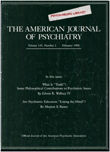Value of difficult temperament among 7-year-olds in the general population for predicting psychiatric diagnosis at age 12
Abstract
The authors assessed the predictive value of "difficult" temperament, as defined in the New York Longitudinal Study, in 12-year-old children from the general population of Quebec City whose temperaments had been determined to be difficult or easy at age 7. The difficult and easy temperament groups were balanced for age, sex, and socioeconomic status. The authors used many convergent measuring devices and were blind to the temperament scores of the children at age 7. Temperamentally difficult children had more clinical disorders at age 12 that qualified for a DSM-III diagnosis. An association with family dysfunction in terms of behavior control seemed to increase this risk: there was a lower rate of clinical disorders among children in superior functioning families than among those in dysfunctional families.
Access content
To read the fulltext, please use one of the options below to sign in or purchase access.- Personal login
- Institutional Login
- Sign in via OpenAthens
- Register for access
-
Please login/register if you wish to pair your device and check access availability.
Not a subscriber?
PsychiatryOnline subscription options offer access to the DSM-5 library, books, journals, CME, and patient resources. This all-in-one virtual library provides psychiatrists and mental health professionals with key resources for diagnosis, treatment, research, and professional development.
Need more help? PsychiatryOnline Customer Service may be reached by emailing [email protected] or by calling 800-368-5777 (in the U.S.) or 703-907-7322 (outside the U.S.).



